|
List of birds of Madeira
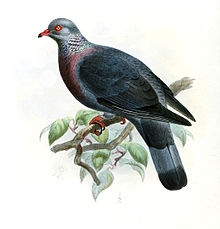 This is a list of the bird species recorded in Madeira. The avifauna of Madeira include a total of 356 species, of which two are endemic, and 9 have been introduced by humans. Two listed species are extinct. This list's taxonomic treatment (designation and sequence of orders, families and species) and nomenclature (common and scientific names) follow the conventions of The Clements Checklist of Birds of the World, 2022 edition.[1] The family accounts at the beginning of each heading reflect this taxonomy, as do the species counts found in each family account. Introduced and accidental species are included in the total counts for Madeira. The following tags have been used to highlight several categories. The commonly occurring native species do not fall into any of these categories.
Ducks, geese, and waterfowlOrder: Anseriformes Family: Anatidae Anatidae includes the ducks and most duck-like waterfowl, such as geese and swans. These birds are adapted to an aquatic existence with webbed feet, flattened bills, and feathers that are excellent at shedding water due to an oily coating.
Pheasants, grouse, and allies Order: Galliformes Family: Phasianidae The Phasianidae are a family of terrestrial birds which consists of quails, partridges, snowcocks, francolins, spurfowls, tragopans, monals, pheasants, peafowls and jungle fowls. In general, they are plump (although they vary in size) and have broad, relatively short wings.
Grebes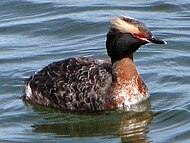 Order: Podicipediformes Family: Podicipedidae Grebes are small to medium-large freshwater diving birds. They have lobed toes and are excellent swimmers and divers. However, they have their feet placed far back on the body, making them quite ungainly on land.
Pigeons and doves Order: Columbiformes Family: Columbidae Pigeons and doves are stout-bodied birds with short necks and short slender bills with a fleshy cere. The Madeiran wood pigeon (Columba palumbus maderensis), an endemic subspecies, is extinct.
Bustards Order: Otidiformes Family: Otididae Bustards are large terrestrial birds mainly associated with dry open country and steppes in the Old World. They are omnivorous and nest on the ground. They walk steadily on strong legs and big toes, pecking for food as they go. They have long broad wings with "fingered" wingtips and striking patterns in flight. Many have interesting mating displays.
Cuckoos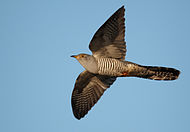 Order: Cuculiformes Family: Cuculidae The family Cuculidae includes cuckoos, roadrunners and anis. These birds are of variable size with slender bodies, long tails and strong legs. The Old World cuckoos are brood parasites.
Nightjars and alliesOrder: Caprimulgiformes Family: Caprimulgidae Nightjars are medium-sized nocturnal birds that usually nest on the ground. They have long wings, short legs and very short bills. Most have small feet, of little use for walking, and long pointed wings. Their soft plumage is camouflaged to resemble bark or leaves.
Swifts Order: Caprimulgiformes Family: Apodidae Swifts are small birds which spend the majority of their lives flying. These birds have very short legs and never settle voluntarily on the ground, perching instead only on vertical surfaces. Many swifts have long swept-back wings which resemble a crescent or boomerang.
Rails, gallinules, and coots  Order: Gruiformes Family: Rallidae Rallidae is a large family of small to medium-sized birds which includes the rails, crakes, coots and gallinules. Typically they inhabit dense vegetation in damp environments near lakes, swamps or rivers. In general they are shy and secretive birds, making them difficult to observe. Most species have strong legs and long toes which are well adapted to soft uneven surfaces. They tend to have short, rounded wings and to be weak fliers.
Cranes Order: Gruiformes Family: Gruidae Cranes (Gruidae) are large, long-legged and long-necked birds. Unlike the similar-looking but unrelated herons, cranes fly with necks outstretched, not pulled back. Most have elaborate and noisy courting displays or "dances".
Thick-kneesOrder: Charadriiformes Family: Burhinidae The thick-knees (Burhinidae) are a group of largely tropical waders in the family Burhinidae. They are found worldwide within the tropical zone, with some species also breeding in temperate Europe and Australia. They are medium to large waders with strong black or yellow-black bills, large yellow eyes and cryptic plumage. Despite being classed as waders, most species have a preference for arid or semi-arid habitats.
Stilts and avocetsOrder: Charadriiformes Family: Recurvirostridae Recurvirostridae is a family of large wading birds, which includes the avocets and stilts. The avocets have long legs and long up-curved bills. The stilts have extremely long legs and long, thin, straight bills.
Oystercatchers Order: Charadriiformes Family: Haematopodidae The oystercatchers (Haematopodidae) are large and noisy plover-like birds, with strong bills used for smashing or prising open molluscs.
Plovers and lapwings Order: Charadriiformes Family: Charadriidae The family Charadriidae includes the plovers, dotterels and lapwings. They are small to medium-sized birds with compact bodies, short, thick necks and long, usually pointed, wings. They are found in open country worldwide, mostly in habitats near water.
Sandpipers and allies   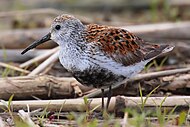 Order: Charadriiformes Family: Scolopacidae Scolopacidae is a large diverse family of small to medium-sized shorebirds including the sandpipers, curlews, godwits, shanks, tattlers, woodcocks, snipes, dowitchers and phalaropes. The majority of these species eat small invertebrates picked out of the mud or soil. Variation in length of legs and bills enables multiple species to feed in the same habitat, particularly on the coast, without direct competition for food.
Pratincoles and coursers Order: Charadriiformes Family: Glareolidae Glareolidae is a family of wading birds comprising the pratincoles, which have short legs, long pointed wings and long forked tails, and the coursers, which have long legs, short wings and long, pointed bills which curve downwards.
Skuas and jaegers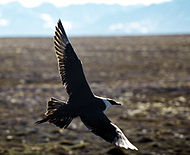 Order: Charadriiformes Family: Stercorariidae The family Stercorariidae are, in general, medium to large sea birds, typically with grey or brown plumage, often with white markings on the wings. They nest on the ground in temperate and arctic regions and are long-distance migrants.
Auks, murres, and puffinsOrder: Charadriiformes Family: Alcidae Auks (Alcidae) are a family of seabirds which are superficially similar to penguins with their black-and-white colours, their upright posture and some of their habits but which are able to fly.
Gulls, terns, and skimmersOrder: Charadriiformes Family: Laridae  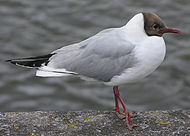  Laridae is a family of medium to large seabirds and includes gulls, terns, and skimmers. Gulls are typically grey or white, often with black markings on the head or wings. They have stout, longish bills and webbed feet. Terns are a group of generally medium to large seabirds typically with grey or white plumage, often with black markings on the head. Most terns hunt fish by diving but some pick insects off the surface of fresh water. Terns are generally long-lived birds, with several species known to live in excess of 30 years.
Tropicbirds Order: Phaethontiformes Family: Phaethontidae Tropicbirds are slender white birds of tropical oceans, with exceptionally long central tail feathers. Their heads and long wings have black markings.
Loons Order: Galliformes Family: Gaviidae The loons or divers are a group of aquatic birds found in many parts of North America and northern Eurasia (Europe, Asia and debatably Africa). All living species of loons are members of the genus (Gavia), family (Gaviidae) and order (Gaviiformes).
Southern storm-petrels Order: Procellariiformes Family: Oceanitidae The southern storm-petrels are relatives of the petrels and are the smallest seabirds. They feed on planktonic crustaceans and small fish picked from the surface, typically while hovering. The flight is fluttering and sometimes bat-like.
Northern storm-petrelsOrder: Procellariiformes Family: Hydrobatidae Though the members of this family are similar in many respects to the southern storm-petrels, including their general appearance and habits, there are enough genetic differences to warrant their placement in a separate family.
Shearwaters and petrels Order: Procellariiformes Family: Procellariidae The procellariids are the main group of medium-sized "true petrels", characterised by united nostrils with medium septum and a long outer functional primary.
StorksOrder: Ciconiiformes Family: Ciconiidae Storks are large, long-legged, long-necked, wading birds with long, stout bills. Storks are mute, but bill-clattering is an important mode of communication at the nest. Their nests can be large and may be reused for many years. Many species are migratory.
Boobies and gannets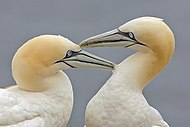 Order: Suliformes Family: Sulidae The sulids comprise the gannets and boobies. Both groups are medium to large coastal seabirds that plunge-dive for fish.
Cormorants and shagsOrder: Suliformes Family: Phalacrocoracidae Phalacrocoracidae is a family of medium to large coastal, fish-eating seabirds that includes cormorants and shags. Plumage colouration varies, with the majority having mainly dark plumage, some species being black-and-white and a few being colourful.
Herons, egrets, and bitterns Order: Pelecaniformes Family: Ardeidae The family Ardeidae contains the bitterns, herons and egrets. Herons and egrets are medium to large wading birds with long necks and legs. Bitterns tend to be shorter necked and more wary. Members of Ardeidae fly with their necks retracted, unlike other long-necked birds such as storks, ibises and spoonbills.
Ibises and spoonbills Order: Pelecaniformes Family: Threskiornithidae Threskiornithidae is a family of large terrestrial and wading birds which includes the ibises and spoonbills. They have long, broad wings with 11 primary and about 20 secondary feathers. They are strong fliers and despite their size and weight, very capable soarers.
OspreyOrder: Accipitriformes Family: Pandionidae The family Pandionidae contains only one species, the osprey. The osprey is a medium-large raptor and a specialist fish-eater with a worldwide distribution.
Hawks, kites and eagles 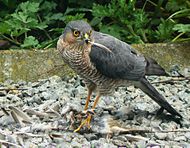 Order: Accipitriformes Family: Accipitridae Accipitridae is a family of birds of prey, which includes hawks, eagles, kites, harriers and Old World vultures. These birds have powerful hooked beaks for tearing flesh from their prey, strong legs, powerful talons and keen eyesight.
Barn-owlsOrder: Strigiformes Family: Tytonidae Barn-owls are medium-sized to large owls with large heads and characteristic heart-shaped faces. They have long strong legs with powerful talons.
Owls Order: Strigiformes Family: Strigidae Typical owls are small to large solitary nocturnal birds of prey. They have large forward-facing eyes and ears, a hawk-like beak and a conspicuous circle of feathers around each eye called a facial disc.
HoopoesOrder: Coraciiformes Family: Upupidae Hoopoes have black, white and orangey-pink colouring with a large erectile crest on their head. .
KingfishersOrder: Coraciiformes Family: Alcedinidae Kingfishers are medium-sized birds with large heads, long, pointed bills, short legs and stubby tails.
Bee-eatersOrder: Coraciiformes Family: Meropidae The bee-eaters are a group of near passerine birds in the family Meropidae. Most species are found in Africa but others occur in southern Europe, Madagascar, Australia and New Guinea. They are characterised by richly coloured plumage, slender bodies and usually elongated central tail feathers. All are colourful and have long downturned bills and pointed wings, which give them a swallow-like appearance when seen from afar.
RollersOrder: Coraciiformes Family: Coraciidae Rollers resemble crows in size and build, but are more closely related to the kingfishers and bee-eaters. They share the colourful appearance of those groups with blues and browns predominating. The two inner front toes are connected, but the outer toe is not.
WoodpeckersOrder: Piciformes Family: Picidae Woodpeckers are small to medium-sized birds with chisel-like beaks, short legs, stiff tails and long tongues used for capturing insects. Some species have feet with two toes pointing forward and two backward, while several species have only three toes. Many woodpeckers have the habit of tapping noisily on tree trunks with their beaks.
Falcons and caracaras Order: Falconiformes Family: Falconidae Falconidae is a family of diurnal birds of prey. They differ from hawks, eagles and kites in that they kill with their beaks instead of their talons.
Old World parrotsOrder: Psittaciformes Family: Psittaculidae Characteristic features of parrots include a strong curved bill, an upright stance, strong legs, and clawed zygodactyl feet. Many parrots are vividly colored, and some are multi-colored. In size they range from 8 cm (3.1 in) to 1 m (3.3 ft) in length. Old World parrots are found from Africa east across south and southeast Asia and Oceania to Australia and New Zealand.
Old-World orioles Order: Passeriformes Family: Oriolidae The Old World orioles are colourful medium-sized passerine birds. The beak is slightly curved and hooked, and, except in the figbirds, as long as the head. The plumage of most species is bright and showy, although the females often have duller plumage than the males. They are not related to the New World orioles.
Shrikes Order: Passeriformes Family: Laniidae Shrikes are passerine birds known for their habit of catching other birds and small animals and impaling the uneaten portions of their bodies on thorns. A typical shrike's beak is hooked, like a bird of prey.
Crows, jays, and magpies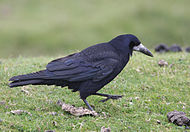 Order: Passeriformes Family: Corvidae The family Corvidae includes crows, ravens, jays, choughs, magpies, treepies, nutcrackers and ground jays. Corvids are above average in size among the Passeriformes, and some of the larger species show high levels of intelligence.
Larks Order: Passeriformes Family: Alaudidae Larks are small terrestrial birds with often extravagant songs and display flights. Most larks are fairly dull in appearance. Their food is insects and seeds.
Reed warblers and allies Order: Passeriformes Family: Acrocephalidae Acrocephalidae (the marsh- and tree-warblers or acrocephalid warblers) is a family of oscine passerine birds, in the superfamily Sylvioidea. Most species are rather plain olivaceous brown above with much yellow to beige below. They are usually found in open woodland, reedbeds or tall grass.
Grassbirds and allies Order: Passeriformes Family: Locustellidae Locustellidae is a family of small insectivorous songbirds ("warblers"), formerly placed in the Old World warbler family. It contains the grass-warblers, grassbirds, and the Bradypterus "bush-warblers". The species are smallish birds with tails that are usually long and pointed. Most live in scrubland and frequently hunt food by clambering through thick tangled growth or pursuing it on the ground.
SwallowsOrder: Passeriformes Family: Hirundinidae  The family Hirundinidae is adapted to aerial feeding. They have a slender streamlined body, long pointed wings and a short bill with a wide gape. The feet are adapted to perching rather than walking, and the front toes are partially joined at the base.
Leaf warblers Order: Passeriformes Family: Phylloscopidae Phylloscopidae is a family of small insectivorous birds formerly placed in the Old World warbler family. Its members occur in Eurasia, ranging into Wallacea and Africa (and the Arctic warbler breeding east into Alaska). Most live in forest and scrub and frequently catch food on the wing.
Sylviid warblers, parrotbills, and allies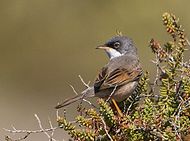 Order: Passeriformes Family: Sylviidae The family Sylviidae is a group of small insectivorous passerine birds. They mainly occur as breeding species, as the common name implies, in Europe, Asia and, to a lesser extent, Africa. Most are of generally undistinguished appearance, but many have distinctive songs.
Kinglets Order: Passeriformes Family: Regulidae The kinglets, also called crests, are a small group of birds often included in the Old World warblers, but frequently given family status because they also resemble the titmice.
WrensOrder: Passeriformes Family: Troglodytidae The wrens are mainly small and inconspicuous except for their loud songs. These birds have short wings and thin down-turned bills. Several species often hold their tails upright. All are insectivorous.
Starlings Order: Passeriformes Family: Sturnidae Starlings are small to medium-sized passerine birds. Their flight is strong and direct and they are very gregarious. Their preferred habitat is fairly open country. They eat insects and fruit. Plumage is typically dark with a metallic sheen.
Thrushes and allies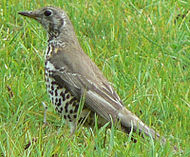 Order: Passeriformes Family: Turdidae The thrushes are a group of passerine birds that occur mainly in the Old World. They are plump, soft plumaged, small to medium-sized insectivores or sometimes omnivores, often feeding on the ground. Many have attractive songs.
Old World flycatchers 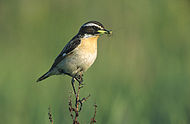 Order: Passeriformes Family: Muscicapidae Old World flycatchers are a large group of small passerine birds native to the Old World. They are mainly small arboreal insectivores. The appearance of these birds is highly varied, but they mostly have weak songs and harsh calls.
Waxbills and allies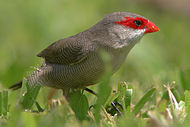 Order: Passeriformes Family: Estrildidae The estrildid finches are small passerine birds of the Old World tropics and Australasia. They are gregarious and often colonial seed eaters with short thick but pointed bills. They are all similar in structure and habits, but have wide variation in plumage colours and patterns.
AccentorsOrder: Passeriformes Family: Prunellidae The accentors are in the only bird family, Prunellidae, which is completely endemic to the Palearctic. They are small, fairly drab species superficially similar to sparrows.
Old World sparrowsOrder: Passeriformes Family: Passeridae Old World sparrows are small passerine birds. In general, sparrows tend to be small, plump, brown or grey birds with short tails and short powerful beaks. Sparrows are seed eaters, but they also consume small insects.
Wagtails and pipitsOrder: Passeriformes Family: Motacillidae 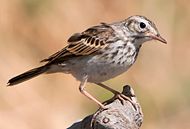 Motacillidae is a family of small passerine birds with medium to long tails. They include the wagtails, longclaws and pipits. They are slender, ground feeding insectivores of open country.
Finches, euphonias, and alliesOrder: Passeriformes Family: Fringillidae Finches are seed-eating passerine birds, that are small to moderately large and have a strong beak, usually conical and in some species very large. All have twelve tail feathers and nine primaries. These birds have a bouncing flight with alternating bouts of flapping and gliding on closed wings, and most sing well.
Longspurs and snow buntingsOrder: Passeriformes Family: Calcariidae The Calcariidae are a small family of passerine birds.
Old World buntingsOrder: Passeriformes Family: Emberizidae The emberizids are a family of passerine birds. They are seed-eating birds with distinctively shaped bills.
New World warblersOrder: Passeriformes Family: Parulidae A group of small, often colourful passerine birds restricted to the New World. Most are arboreal and insectivorous.
See alsoReferences
External links
|

